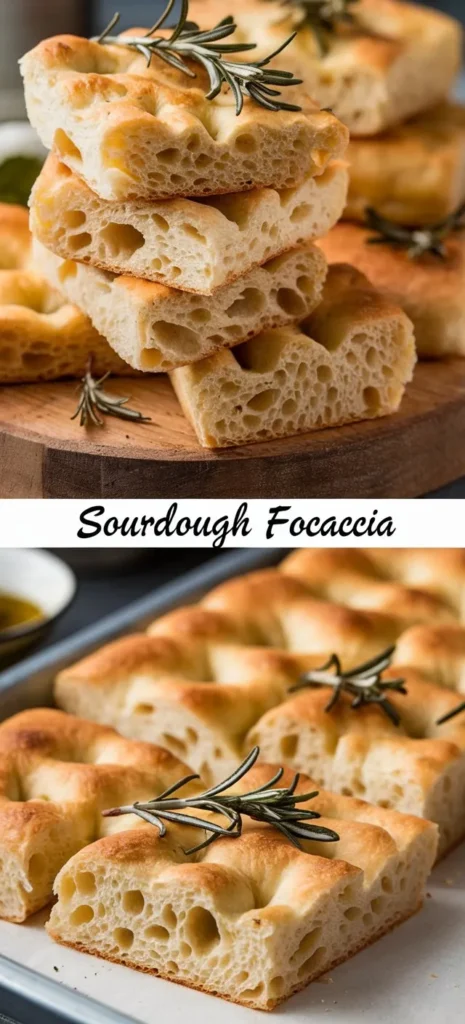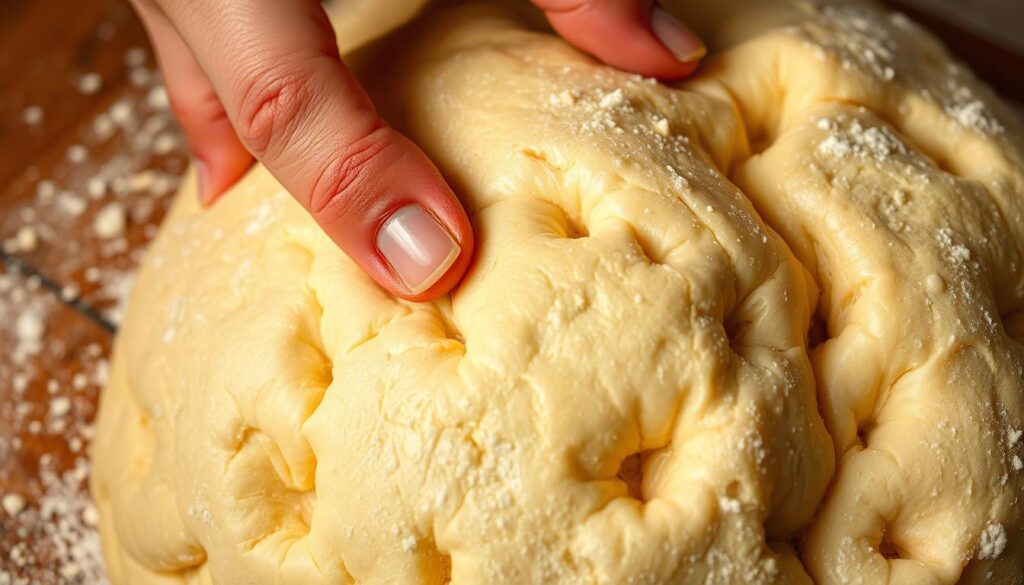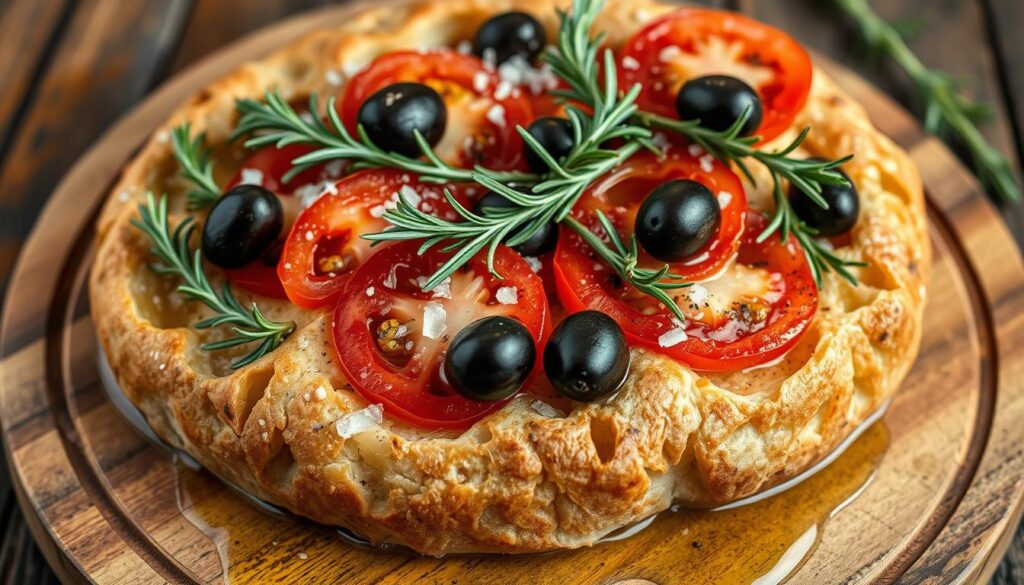Walking into a warm kitchen filled with the smell of fresh bread is truly special. It’s even more so when that bread is homemade sourdough focaccia. The first time I touched the airy, bubbly focaccia, I felt a deep connection to sourdough baking. It’s not just cooking; it’s a labor of love that turns simple ingredients into something amazing.
Making your own sourdough focaccia is a unique experience. It’s a chance to slow down and enjoy the moment. It brings happiness not just to you, but to everyone who shares a slice at the table.
Let’s dive into the art of making this bread. You’ll learn why homemade sourdough focaccia is so special. This recipe will help you create a beautiful, dimpled bread that’s perfect for sandwiches or appetizers. Whether you’re a pro or a beginner, the journey is as rewarding as the bread itself. So, let’s start our baking adventure together!

- Introduction to Sourdough Focaccia
- Why Choose Sourdough Focaccia?
- Essential Ingredients for Sourdough Focaccia
- Sourdough Focaccia Recipe: Step-by-Step Guide
- Shaping and Second Rising the Dough
- Creating Those Signature Dimples
- Baking Your Sourdough Focaccia
- Toppings and Variations for Sourdough Focaccia
- Storing and Reviving Leftover Focaccia
- Conclusion
- Source Links
Introduction to Sourdough Focaccia
Sourdough focaccia is a beloved part of Italian cuisine. It’s known for its airy texture and rich flavor. Unlike regular sandwich breads, it has a crispy crust and chewy crumb. This makes it a great base for many toppings.
Making sourdough focaccia is a simple yet rewarding process. You need high-quality ingredients like strong white bread flour, olive oil, and fresh herbs. The fermentation process, which includes an overnight prove, adds to the flavor. This makes every bite a joy.
Sourdough baking is becoming more popular, and focaccia is a favorite among home bakers. Making sourdough focaccia lets you connect with a long-standing tradition. You can also add your own touches, like rosemary and garlic confit.
By trying this, you not only enjoy the delicious results but also the joy of making something from scratch. If you’re ready to start, I recommend a great sourdough focaccia recipe. It captures the essence of this beloved bread.
Why Choose Sourdough Focaccia?
Sourdough focaccia offers a world of flavors and textures. Its unique sourness and improved digestibility are key benefits. The fermentation process breaks down gluten and boosts nutrient absorption.
The dough’s bubbly starter makes it chewy yet airy. This texture is both satisfying and enjoyable. It’s perfect for those who love baking.
Preparing sourdough focaccia is easy and fun. It doesn’t need instant yeast like regular recipes. Instead, it uses fermentation for a delicious, versatile loaf.
Adding toppings like rosemary, garlic, and sea salt makes it even better. You can customize it to your liking.
Kneading and baking by hand are therapeutic. It’s calming and rewarding to see your focaccia come out perfectly. It connects you to traditional baking practices.
| Factors | Sourdough Focaccia | Traditional Yeast Focaccia |
|---|---|---|
| Flavor | Complex and tangy | Milder and sweeter |
| Texture | Chewy and airy | Dense and uniform |
| Health Benefits | Better digestibility, nutrient absorption | Standard fermentation |
| Preparation Time | Requires overnight rising | Quick and straightforward |
With a 4.9 out of 5 star rating from 96 reviews, sourdough focaccia is a hit. It’s a mix of art and science that’s worth the wait.
For more on sourdough, check out this resource.
Essential Ingredients for Sourdough Focaccia
To make the perfect sourdough focaccia, you need to know the key ingredients. For my recipe, I use:
- 1 cup of active sourdough starter
- 1½ cups of warm water (between 76°F and 82°F)
- ½ cup of extra virgin olive oil (plus an additional tablespoon for drizzling)
- 1 tablespoon of honey
- 2 teaspoons of sea salt
- 4 cups of all-purpose flour or high-protein bread flour for a chewier texture
- 2 sprigs of fresh rosemary
- 1 teaspoon of garlic powder

A bubbly and mature sourdough starter is key for a great focaccia. It makes the dough rise and adds flavor. Bakers often choose King Arthur flour for the best results.
The right mix of ingredients is important. For example, using 180 grams of sourdough starter is vital. Warm water helps the dough come together and makes it easier to work with.
| Ingredients | Quantity | Function |
|---|---|---|
| Sourdough starter | 1 cup (180g) | Leavening agent, flavor |
| Warm water | 1½ cups | Hydration, activation |
| Olive oil | ½ cup + 1 tbsp | Flavor, texture |
| Honey | 1 tbsp | Flavor, browning |
| Sea salt | 2 tsp | Flavor, strength |
| Flour | 4 cups | Dough structure |
| Fresh rosemary | 2 sprigs | Topping, aroma |
| Garlic powder | 1 tsp | Flavor |
With these ingredients, you can make your focaccia your own. Try adding olives, onions, or different cheeses for new tastes. Getting the ingredients right is the first step to making delicious sourdough focaccia.
If you’re new to baking, finding great recipes and tips is helpful. Check out great recipe collections to improve your skills and enjoy baking more.
Sourdough Focaccia Recipe: Step-by-Step Guide
Making sourdough focaccia is all about following the right steps. It starts with getting your sourdough starter ready. This starter needs to be at its peak to give your focaccia the perfect texture and taste.
Preparing the Sourdough Starter
To start, I mix my starter with water and flour. I use a 1:4:4 ratio. This means ¼ cup of starter, 1 cup of water, and 1 cup of flour. After a few hours, it’s bubbly and ready to go.
Mixing the Dough
Next, I mix the dough. I add 3 cups of flour, 1 ⅓ cups of water, 1 ½ teaspoons of salt, and 1 tablespoon of olive oil. I mix it at low speed for five minutes, then at medium speed for another five. This helps the dough develop the right structure for rising.
First Rise: Overnight Fermentation
The dough then gets to rest overnight. I let it rise at room temperature for four hours. Then, I refrigerate it for 12-16 hours. This slow rise makes the focaccia taste better and stay light.
Overnight fermentation is key for deep flavors and a good dough consistency. When I shape it the next day, it should be airy and well-risen. This shows it’s fermented properly.
Shaping and Second Rising the Dough
Shaping focaccia dough is key to getting that perfect airy texture. I start by gently working with the dough. This keeps its delicate structure formed during bulk fermentation.
This process turns a sticky mess into a puffy treat ready for the oven.
After the first rise, it’s time for the dough to rise again in a 10×15-inch baking pan. This size helps my focaccia get about 1¾ inches tall. I shape the dough on a floured surface, stretching it into the pan.
I make sure it fills the corners and keeps its gas bubbles. This step is important for the dough’s structure.
Next, I let the dough rest and rise for about 30 minutes. I cover it with a damp cloth to keep it moist. This helps the dough reach the perfect temperature for fermentation.
The second rise is when the dough gets its final volume. This makes it irresistibly fluffy when baked.
Watching the dough closely helps it rise another 50% in height. This makes my focaccia truly special during baking.
Creating Those Signature Dimples
Dimpling focaccia dough is key to getting that sourdough focaccia texture we all adore. It’s not just for looks; it affects the bread’s structure and taste. Dimples keep moisture in, holding toppings like herbs or coarse sea salt in place, making each bite full of flavor.
The dimpling technique is simple yet effective. Using my fingers with olive oil helps prevent sticking, making it easier to create deep, clean indentations. The dimples should be about half an inch deep. This allows the dough to rise but prevents holes.

These dimples do more than just look good. They help the bread stay warm and moist during baking, giving it a light, airy crumb. Keeping the dough covered while dimpling prevents the crust from forming, ensuring an even finish.
Here are the main points for dimpling focaccia dough:
- Use well-oiled fingers to prevent sticking.
- Dimples should be about half an inch deep.
- Maintain a gentle pressure to create even indentations.
- Cover the dough after dimpling to retain moisture.
Spending time on dimpling your focaccia makes a big difference. Follow these tips for a great result every time you bake.
Baking Your Sourdough Focaccia
Baking sourdough focaccia needs careful attention for the best results. Knowing the right techniques can make a big difference. With the right temperature and methods, you can get perfect focaccia. Follow these steps to make sure your focaccia turns out just right.
Checking for Doneness
Checking focaccia doneness involves looking and feeling. Start by heating your oven to 450°F (232°C). After baking for 25-30 minutes, it should have a deep golden crust. To check if it’s done, tap the bottom; a hollow sound means it’s ready.
The focaccia should also feel firm but slightly soft. This shows the dough has fermented well and cooked evenly. Remember, every oven is different, so watch your focaccia closely in the last minutes to avoid overbaking.
Once you take the focaccia out of the oven, let it cool for at least 30 minutes. Cooling is key as it helps the inside set. It also enhances the flavor, allowing the dough to develop more with each minute.
| Step | Time | Details |
|---|---|---|
| Preheat Oven | N/A | To 450°F (232°C) |
| Baking Time | 25-30 minutes | Check for deep golden color and hollow sound |
| Cooling Time | 30 minutes | Essential for setting texture and flavor |
| Total Time | Approx. 1 hour | Includes baking and cooling phases |
Toppings and Variations for Sourdough Focaccia
Sourdough focaccia is a great base for many toppings. I love trying out sourdough focaccia toppings from classic to new. Herbs like thyme, rosemary, oregano, and sage are favorites of mine. They add strong flavors that stand up to baking.
When picking variations for focaccia, be careful with wet ingredients. Big tomatoes can make the focaccia soggy. Smaller sweet tomatoes are better for flavor and structure. A mix of tomato, garlic, and thyme is always a hit.
For creative focaccia ideas, try unique combos. Potato, reblochon cheese, and sage create tasty pockets. Blackberries, blue cheese, and honey offer a sweet and savory mix. Sweet onion and rosemary are simple yet effective.
To keep toppings in place, drizzle olive oil on the focaccia. It helps the crust get crispy and keeps toppings from falling off. Here are some favorite toppings:
| Topping | Flavor Profile |
|---|---|
| Rosemary and Sea Salt | Classic and aromatic |
| Olives with Lemon Zest | Briny with a citrus kick |
| Grapes with Fennel Seeds | Sweet and herby |
| Pesto with Chicken | Savory and rich |
| Potato, Reblochon Cheese, and Sage | Earthy and creamy |
| Blackberry, Blue Cheese, and Honey | Tangy with a hint of sweetness |
| Sweet Onion and Rosemary | Sweet and fragrant |

Each batch of dough, about 1000 grams or 2 pounds, makes six slices. It’s perfect for sharing. The whole process takes about 6 hours and 50 minutes, including an overnight rise. Start making your own focaccia creations today!
Storing and Reviving Leftover Focaccia
Keeping sourdough focaccia fresh is key. Store any leftover focaccia in an airtight container. This keeps its texture and taste great. You can also wrap it in plastic wrap and put it in a zip-top bag. This way, it stays soft for up to three days at room temperature.
When focaccia gets stale, reviving it is easy. Just preheat your oven to 350°F (175°C). Warm the focaccia for 10-15 minutes. This makes it soft and fragrant again. Adding olive oil before heating can make it even tastier.
Want to use up stale focaccia? Turn it into croutons or breadcrumbs. Cube the stale focaccia, toss with olive oil and seasonings. Then, bake at 375°F (190°C) until golden. This reduces waste and adds a tasty topping to salads or soups.
Learning to store and revive focaccia is a game-changer. It lets me enjoy every bite of this tasty bread, even after it’s cooled down. For more tips on making sourdough focaccia, check out this sourdough focaccia guide.
Conclusion
Making homemade sourdough focaccia has been incredibly rewarding for me. This bread is easy to make, versatile, and full of flavor. It’s a joy to create something special in my kitchen, beating any store-bought bread in taste and texture.
The recipe is worth the time and effort. It’s also cost-effective, unlike the pricey focaccia found in cafes and restaurants. The recipe includes all the necessary steps and ingredients for a perfect bake.
High-quality bread flour and extra virgin olive oil are key to success. Sourdough focaccia became popular during the pandemic and is loved by many home bakers. If you haven’t tried it yet, I suggest you give it a go.
Reflecting on my baking journey, I’m excited to try new toppings and variations. You can add fresh herbs, flavored salts, olives, or sun-dried tomatoes to your focaccia. For a detailed recipe and tips, check out this link. Happy baking!
Source Links
- Simple Sourdough Focaccia Bread Recipe | Alexandra’s Kitchen – https://alexandracooks.com/2019/03/22/simple-sourdough-focaccia-a-beginners-guide/
- Simple Sourdough Focaccia Bread [bubbly + delicious] – https://www.pantrymama.com/simple-sourdough-focaccia-bread/
- sourdough focaccia – The simplest way to make sourdough – https://foodbodsourdough.com/tag/sourdough-focaccia/
- Sourdough Focaccia Bread Recipe – https://stretchandfolds.com/sourdough-focaccia-bread-recipe/
- Sourdough Focaccia with Garlic Confit – https://momentsofsugar.substack.com/p/sourdough-focaccia-with-garlic-confit
- Beginner’s Guide To Sourdough Focaccia Bread – The Clever Carrot – https://www.theclevercarrot.com/2022/04/best-sourdough-focaccia-bread-recipe/
- Sourdough Focaccia 101 — Kendall Andronico – https://www.kendallandronico.com/all-recipes/sourdough-focaccia-101
- Easy Sourdough Focaccia – https://www.farmhouseonboone.com/easy-sourdough-focaccia/
- Sourdough Focaccia – The Bold Appetite – https://boldappetite.com/sourdough-focaccia/
- Sourdough Focaccia – https://www.kingarthurbaking.com/recipes/sourdough-focaccia-recipe
- Sourdough Focaccia with Rosemary and Garlic – https://littlespoonfarm.com/sourdough-focaccia-rosemary-garlic-recipe/
- Sourdough focaccia recipe – Sourdough Explained – https://sourdoughexplained.com/how-to-make-sourdough-focaccia/
- How to Make Sourdough Focaccia – Lemons + Anchovies – https://lemonsandanchovies.com/2023/05/how-to-make-sourdough-focaccia/
- Easy Sourdough Focaccia – Grant Bakes – https://grantbakes.com/easy-sourdough-focaccia/
- Cinnamon Roll Sourdough Focaccia – https://amybakesbread.com/cinnamon-roll-sourdough-focaccia/
- Hawaiian Roll Sourdough Focaccia – https://countryroadssourdough.com/hawaiian-roll-sourdough-focaccia/
- Easy Sourdough Focaccia – https://countryroadssourdough.com/sourdough-focaccia/
- Easy Sourdough Focaccia – Perfect for Beginners – https://www.supergoldenbakes.com/sourdough-focaccia-recipe/
- Sourdough Focaccia Bread – https://amybakesbread.com/sourdough-focaccia/
- Focaccia Topping Guide — Bake with Jack – https://www.bakewithjack.co.uk/blog-1/2022/5/19/focaccia-topping-guide
- Crispy Fluffy Sourdough Focaccia – https://feelingfoodish.com/crisp-and-fluffy-sourdough-focaccia/
- The Best, Easiest Focaccia Bread Recipe | Alexandra’s Kitchen – https://alexandracooks.com/2018/03/02/overnight-refrigerator-focaccia-best-focaccia/
- Focaccia Made with Sourdough Discard and Scrappy Toppings – Zero-Waste Chef – https://zerowastechef.com/2022/08/10/sourdough-discard-focaccia-scrappy-toppings/
- easy sourdough focaccia – https://www.girlversusdough.com/easy-sourdough-focaccia/
- Sourdough was swell, but homemade fresh focaccia rises to another level – https://www.seattletimes.com/pacific-nw-magazine/sourdough-was-swell-but-homemade-fresh-focaccia-rises-to-another-level/
- Perfect Sourdough Focaccia: A Simple Step-by-Step Guide – https://www.sourdoughsymphony.com/stream/sourdough-focaccia/
- Sourdough Focaccia – https://www.femalefoodie.com/recipes/sourdough-focaccia/

